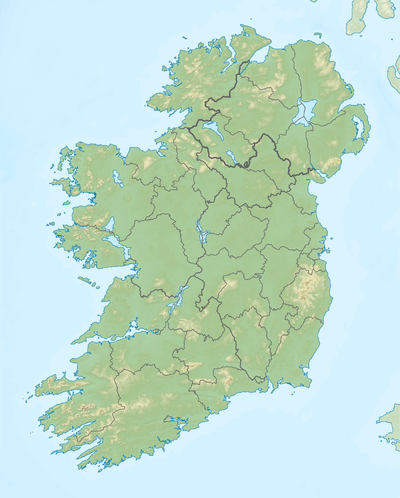Croghan Hill
| Croghan Hill | |
|---|---|
 Croghan Hill, from the southwest | |
| Highest point | |
| Elevation | 234 m (768 ft) |
| Listing | Marilyn |
| Coordinates | 53°20′48″N 7°16′39″W / 53.34667°N 7.27750°W |
| Geography | |
 Croghan Hill Location in Ireland | |
| Location | Offaly, Ireland |
| OSI/OSNI grid | N482331 |
| Topo map | OSi Discovery 48 |
| Geology | |
| Age of rock | > 1,000,000 yr |
| Mountain type | Extinct volcano |
Croghan Hill is the remains of an extinct volcano[1] of the Carboniferous period and rises from the Bog of Allen in the midlands of Ireland in County Offaly. Though only 234 metres (768 ft) high[1] it commands extensive views of the surrounding midland counties, across the flat, low-lying expanse of the Bog of Allen. The village of Croghan is located on the southern slope of the hill.
Historical associations
The mound at the summit is thought to be a Bronze Age burial place. It is believed that a Bishop MacCaille had his church there and lived around the time of St Patrick in the fifth century. The area also has strong associations with St. Bridget, who is said to have been born near Croghan hill. In pre-Christian times, Brigid as Brig, Bree or Bri was also associated with the Hill, and the inside believed to be a magic underworld called Bri Ele.[2] Seen from Uisnech, the pointed summit coincides with the midwinter sunrise.
The O'Connors of Offaly, the old Gaelic rulers before colonisation and plantation in the sixteenth century, had one of their main residences here, and it was also the place of inauguration of their chiefs. Just north of the hill is a holy well dedicated to St. Patrick (signposted). The late Frank Mitchell, the celebrated geologist, preferred to give the distinction of the "navel of Ireland" not to the hill of Uisneach (26 kilometres (16 mi) north-east of Athlone) but to the isolated hill, Croghan, which he described as a mass of volcanic rock. While accepting that Croghan Hill was not at the geographical centre of Ireland, Mitchell chose Croghan Hill because it lies in the heartland of the great raised bogs of the midlands. The cooling towers of at least four peat-fired generating stations (when they were operational) could be seen from the summit.
The Croghan Hill area is also notable for the 2003 discovery of Old Croghan Man, the remarkably preserved bog body of a high-status man of the early Iron Age who is believed to have died some time between 362 BC and 175 BC.
See also
References
- 1 2 "Croghan Hill". MountainViews.ie. Retrieved 15 February 2014.
- ↑ Dames, Michael (1992). Ireland: A Sacred Journey. Element Books. ISBN 978-1862044463.
External links
| Wikimedia Commons has media related to Croghan Hill. |
Coordinates: 53°20′48″N 7°16′39″W / 53.34667°N 7.27750°W
